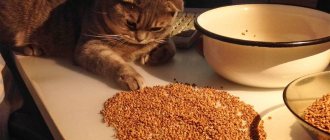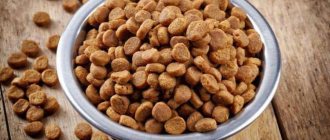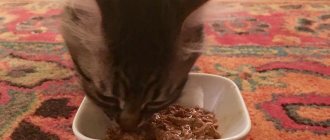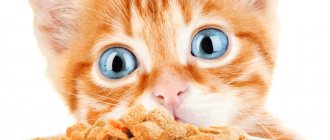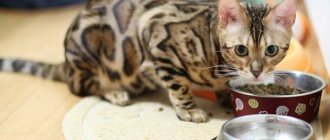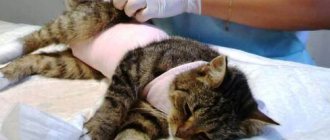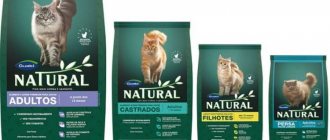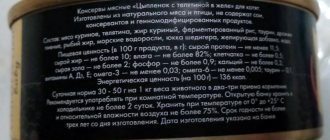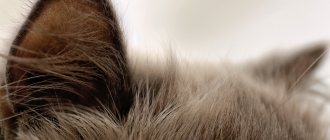The shelves of pet stores are replete with many types of industrial ready-made professional food for cats. Many of them, especially the line of economy and super-economy class products, can cause irreparable harm to the health of your furry pet.
Owners who sincerely want to see their animal happy for many years often think about preparing food for cats at home. Sometimes this is prompted by an animal’s illness, in which feeding with dry food is prohibited. Not every owner can afford to purchase expensive high-quality dry or wet premium canned professional food for a cat based on the latest technologies. Cheap food, richly flavored with artificial flavors and dyes that enhance the smell and attract the animal, can cause food addiction, similar to a drug addiction. In this article we will look at what you can prepare for your cat from homemade food.
Some owners immediately feed their pets natural food, while others come to this later, having appreciated the benefits of this type of food. Products for this are almost always available in the refrigerator; they are much cheaper than ready-made commercial feed.
Many owners want to independently create a healthy home menu, preferable for the cat’s sensitive stomach, without preservatives, sugar, chemicals, bones, reducing the risk of food poisoning and allergies, while you can always control the menu and pet’s diet.
Principles of natural nutrition
With natural feeding, pets do not receive nutritious industrial mixtures, but products prepared by humans themselves. Such food must meet certain requirements:
- Completely meet the cat's needs for basic and additional nutrients.
- Be safe for your pet, that is, do not contain pathogenic bacteria and parasites.
- Natural food must not contain substances harmful to cats - GMOs, hormones, pesticides, components that are contraindicated for pets.
If you don’t know what diet is best to choose for your pet, we recommend reading the article on cat nutrition on our portal.
The diet of animals must include:
- Squirrels. A predator, which is a cat, must obtain this element mainly from meat (about 80% of the diet).
- Fats. Preference should be given to products of animal origin, while the plant component, although in a smaller part, is necessary.
- Carbohydrates. They are a source of energy for any mammal, so they must be in a cat’s diet every day, but in small quantities.
- Cellulose. Ensures proper functioning of the gastrointestinal tract and complete digestion of food, therefore it is a mandatory ingredient in the daily diet with a natural diet.
- Vitamins, micro- and macroelements. They compensate for the lack of calcium, phosphorus, magnesium, iodine, selenium, and other components that provide the animal with healthy skin, coat, and proper functioning of the cardiovascular and musculoskeletal systems.
- Water. It should always be present in the cat’s natural diet in its pure form and in unlimited quantities.
When feeding a natural diet, it is important to ensure that the cat does not have vitamin deficiency, in order to notice this condition in time, read the article here.
Expert recommendations for choosing a nutritious diet
Veterinarians are also positive about formulating a diet for cats based on natural products. Currently, the BARF (Biologically Appropriate Raw Food) system is widely used in Europe and America. It was invented in the nineties of the last century by veterinarian Ian Billinghurst from Australia. However, feeding only raw foods is associated with certain risks for the health of cats, so our doctors adhere to the need for heat treatment.
Video: veterinarian talks about the correct natural diet of an animal
What components must be present in a cat's diet?
A balanced diet includes proteins, fats, carbohydrates and vitamin-mineral complexes. Their quantity and daily calorie intake are determined based on data on the cat’s age and weight: for this purpose, it is recommended to use reference tables.
Based on these data, you can calculate the amount of necessary components in the diet.
What foods should be included in a cat’s diet:
- Meat, poultry and meat products are the main source of protein and essential amino acids. They should be served raw (exclusively after freezing), boiled or stewed. It is recommended to use lean beef, lamb, rabbit, chicken and turkey to feed your cat. Lamb, pork, duck and quail are too heavy for the animal's stomach, as they contain a lot of fat. Among meat products, preference should be given to ventricles, hearts and liver.
- Fish contains lipids, amino acids, phosphorus and magnesium. It is recommended to use sea fish to feed cats: unlike freshwater fish, it does not accumulate toxic substances in its composition. Fish should be given boiled, after removing the head, fins, tail, scales and all bones: these components are not digested in the stomach. The most useful fish include: pink salmon, hake, salmon, trout, taimen.
- Butter and vegetable oil are essential sources of fats and vitamin E, help strengthen vascular walls and increase resistance to infections. A lack of fat in an animal's diet can lead to reproductive dysfunction. Oil should be added to food in an amount of no more than half a teaspoon.
- Dairy products and eggs. Dairy products are rich in calcium and protein and are easily digestible by your pet's body. These include kefir, fermented baked milk, natural yoghurts without additives, cottage cheese, sour cream. Mostly the yolk is used from eggs for cat diet: it contains the required amount of fat.
- Porridges and cereals act as a source of slowly digestible carbohydrates. To feed your furry pets you should use buckwheat, oatmeal or rolled oats, millet, rice, boiled in water. It is better to avoid semolina porridge: it has no nutritional value and contains only empty carbohydrates.
- Vegetables are not only a source of healthy vitamins, but also fill the need for fiber. It improves the functioning of the gastrointestinal tract and stimulates digestion processes. Vegetables need to be boiled, baked or ground into a paste using a blender. Most often, cats' menu includes pumpkin, zucchini, broccoli, carrots, and beets. Cabbage, potatoes, legumes and peas cause excessive gas formation, so they are not used. You can use spinach, green onions, celery, and basil as healthy additives.
Cats can often develop interesting taste preferences. The cat of my grandmother, who lived in the village, loved raw cucumbers very much and regularly stole them from the garden. The fluffy pet could handle a whole cucumber alone and never refused a supplement. My sister's cat really loves bananas and melons, but since they contain a lot of sugar, the animal manages to enjoy them only occasionally.
Photo gallery: healthy food for pets
Meat should be served cut into small cubes
Dairy products are rich in calcium
Cereals satisfy the need for slow carbohydrates
Vegetables are the best source of fiber and vitamins
What foods should you avoid altogether?
Some foods and additives familiar to humans are strictly prohibited from being used in the diet of cats. The body of furry pets is much more sensitive to various food components. An incorrectly formulated diet can lead to the development of serious diseases of the liver, stomach, bones and joints, or even cause premature death.
What should not be added to a cat's diet:
- Ketchup, mayonnaise, adjika and any other sauces. They contain a lot of spices and can also be very salty and spicy. If you think that the dish prepared for your pet is dry, it is better to dilute it with sour cream or meat broth.
- Meat trimmings, chicken skin, chicken bones. These leftovers do not provide any nutritional value, but can become ballast for your pet's digestive system. Sharp edges of bones and their fragments can injure a cat's delicate gastrointestinal tract.
- Sausage, frankfurters, sausages, stewed meat, meat pates. These products are more adapted to the human diet: they contain many third-party additives and soy, but they cannot replace real meat.
- Sweet yoghurts, snowballs, condensed milk, ice cream. Despite the fact that these products also belong to the dairy category, they contain too much sugar. It has been proven that even minor consumption of condensed milk creates a risk of damage to the pancreas and the development of diabetes in cats.
- Floury. Bread, any pastries and cookies are poorly absorbed in the body of a furry pet and provoke constipation.
- Tea. Many owners are touched when their cat drinks the rest of the tea from their mug. However, tea (especially black tea) contains caffeine, which has a stimulating effect on the animal’s nervous system and leads to the development of restless behavior and hyperactivity.
While studying at the university, in one of the classes on clinical laboratory diagnostics, we studied the composition and properties of urine using the example of cat urine. One of my classmates collected urine from her cat and brought this sample to class for research. Our teacher conducted several tests with special strips that detect the presence of glucose in urine: they turned out to be positive. It turned out that the day before, a classmate fed her cat sweet yogurt: this caused a sharp jump in sugar levels in the animal’s body. The teacher recommended reconsidering the furry pet’s diet and giving up such food forever.
Photo gallery: prohibited products for animals
Sausages contain a lot of soy and third-party additives
Flour slows down your cat's digestion
Mayonnaise contains a lot of fat
Mr. Cat recommends: advantages and disadvantages
Proponents of natural cat nutrition often talk about the exceptional advantages of such a diet, sometimes forgetting about its disadvantages. And they are important:
- There is a high risk of infection for pets when using low-quality products or failing to comply with their storage conditions. This is especially important if pets are “on raw meat”.
- Difficulty achieving a properly balanced diet.
- The need to purchase and regularly include special vitamin and mineral supplements in animal nutrition.
- Increased time and financial costs for purchasing and preparing a daily diet.
- The most basic knowledge about feline nutrition. They are necessary to ensure that cats’ nutrition is complete and balanced.
- The need for a special diet in case of animal illness. It is much more difficult to find it with a natural diet.
- Maintaining hygiene when storing and preparing cat food is an important factor in maintaining the health of your pets.
But the benefits of natural cat nutrition still attract many owners:
- There are no chemical or artificial components in cat food.
- All pets like a diet of meat; such feeding is natural for predators.
- Possibility of preparing meals taking into account the taste preferences of cats.
- With the correct selection of products, this feeding regimen has a more beneficial effect on the pet’s body.
When feeding cats naturally, regularity of food intake is very important.
If dry food can always be in a cat’s bowl and the animal chooses when and how much to eat, then meat, cereals, dairy products, fruits and vegetables should be given to the pet as many times a day as required by age, weight and size:
- Up to three months, young animals are fed six times a day.
- From three to four - five.
- Four to six month old kitten - four times.
- From six months the cat is fed three times a day.
- After a year, the cat is either transferred to two meals a day, or continues to be fed three times a day, depending on the individual characteristics and preferences of the pet.
It is recommended to give a single dose of natural food to the cat at the same time and in a certain place that the pet loves. The temperature of the food should be comfortable for the animal; food from the refrigerator should be heated.
If there are several pets in the house, each should receive their portion in a separate bowl.
Water should always be in an accessible place, clean and of high quality.
Chum salmon steaks in orange sauce
- peeled chum salmon steaks - 5 pcs.
- olive oil - 1.5 tbsp. l.
- orange juice - 1.5 tbsp. l.
- orange - 1 pc.
- soy sauce - 1.5 tbsp. l.
- fresh dill - 1 bunch
- ground black pepper
- Combine oil with soy sauce and orange juice.
- Leave the washed fish steaks in the prepared marinade for half an hour.
- Turn the fish every 8 minutes to coat evenly.
- Cut the citrus into slices.
- Place the fish on a baking sheet and cover with orange on top.
- Cooking temperature - 180°C, cooking duration - 25 minutes.
Protein sources
Animal proteins are necessarily the main component of a cat’s natural diet. They most often serve the following types of meat:
- poultry - chicken, turkey, some parts of duck;
- beef;
- rabbit and lamb meat;
- for kittens, it is desirable to have puree or small pieces of meat with vegetables;
- low-fat varieties of fresh sea fish.
Meat and fish can be used both raw and boiled. In the latter case, it is necessary to remove all the bones, otherwise they can damage the walls of the stomach, intestines, esophagus, and larynx.
When feeding raw meat, it must first be thoroughly frozen, preferably in industrial refrigeration chambers at a temperature of about -40 °C. Or keep for at least three days in household freezers.
After defrosting, be sure to rinse thoroughly with plenty of clean running water.
Fish should not be given to cats at any age more than once or twice a week.
Ready-made meat puree (baby food) is allowed for small kittens and adults with sensitive digestion or diseases of the gastrointestinal tract.
The following types of protein are also acceptable; they are included in pets’ diets in smaller quantities than meat:
- chicken, quail, turkey, goose eggs - mainly raw;
- low-fat cottage cheese and kefir;
- hard cheeses with a minimum amount of salt and unsweetened natural yoghurts.
If the cat does not like the taste of cottage cheese, it can be mixed with yogurt, fermented baked milk, or kefir. Cheese should not be given more than once every seven days.
Why is it better to cook for cats yourself?
Making your own cat food is not difficult at all. After all, although industrially produced food makes our lives much easier, they often contain ingredients that cannot be included in the diet of our pets. That is why every year there are more and more people who prefer a natural diet prepared in the home kitchen to commercially produced food.
Food specially prepared for a cat from healthy and fresh ingredients does not necessarily have to be the basis of his diet. You may be feeding him store-bought food more often, but it’s still worth making a healthy and enjoyable addition to your pet’s diet. And if you have enough free time, then the cat can be completely switched to food that you prepare yourself. It will be more natural than any food you can find in a pet store. But remember that you cannot simply feed your cat the same food that you yourself eat for dinner; these pets have dietary habits that must be observed. Therefore, you will have to cook for them separately.
Sources of fats
This element must be included in a cat’s natural diet, since it is not only, along with carbohydrates, a source of energy, but also supplies the body with many vitamins:
- A - improves vision, is responsible for the condition of the skin and coat;
- D - is of great importance for the formation of the skeleton;
- E - strengthens muscles, regulates the normal functioning of the genitourinary system;
- K - is an important element for strengthening joints and bones, and the functioning of the cardiovascular system.
In addition, fats give food an attractive taste and smell, promote intensive growth and harmonious development of the animal. Their share in the pet’s diet with natural nutrition should be at least 20%.
If it is not possible to provide the animal with food with a sufficient amount of these components, then fish oil can be added to it.
Chum salmon steaks with tomatoes and cheese in the oven
- cut steak - 5 pcs.
- onion - 1 pc.
- tomatoes - 3 pcs.
- rast. oil - 3 tbsp. l.
- parmesan - 150 g.
- salt
- freshly ground pepper
- spices
We tell you how to cook the most tender steaks from chum salmon, so that it is the juiciest, in the oven.
- Prepare the steaks in advance.
- Place them in a heat-resistant glass dish for further baking.
- Add salt, pepper and spices.
- Chop the onion into rings. Chop the tomatoes into slices and sprinkle with Parmesan.
- First place the chum salmon on the foil in layers, then place the tomatoes and cheese on top of it.
- Cover with foil and place in a preheated oven for 20 minutes.
- After the specified period of time, open the foil and let the cheese brown a little for another 5 minutes.
Carbohydrates and fiber in natural foods
To replenish this important nutritional element and ensure high-quality digestion of food with a natural diet, raw, boiled, steamed vegetables, fruits and berries must be included in the cat’s diet.
Not all animals are attracted to the taste of apples, greens, cranberries, blueberries, legumes, and carrots. You can add a little sunflower or olive oil to this food, and also mix it with pieces of meat or puree.
Preference should be given to cauliflower, broccoli, lettuce, zucchini, pumpkin, and apples. But some vegetables are on the list of prohibited foods (more on that below) and are not recommended for cats. Oatmeal and pearl barley porridge can be included in the diet of pets. It is not recommended to give semolina porridge, i.e. wheat.
Tender chum salmon fillet with vegetables and butter
- chum salmon fillet - 0.5 kg.
- mixed vegetables (frozen) - 0.3-0.4 kg.
- broccoli - 0.15 kg.
- dried basil - 1 pinch
- drain butter - 40 gr.
- salt
Since you can cook chum salmon deliciously in the oven in several ways so that it is juicy and crispy, we recommend evaluating the recipe with butter.
- Place the fillet on foil. Grate with chopped basil.
- Place broccoli and thawed vegetable mixture next to it and add salt.
- Carefully wrap the foil so that the ingredients do not fall out.
- Place the butter, cut into pieces, in the center.
- Place the dish completely wrapped in foil in the oven (180°C).
- It will take 20 minutes for the fish to be fully cooked.
- After this time, you can remove the top part of the foil and let the food brown.
Vitamins and minerals
These elements are very important in a natural diet. To replenish them, cats should be given specially grown grass or sprouted oats. Recommends selectively adding brewer's yeast to animal food to replenish B vitamins.
Since the usual food that a person can offer to their pets, as a rule, contains an insufficient amount of vitamins and minerals, when feeding cats on a natural basis, it is imperative to give cats special vitamin and mineral complexes. They contain important nonessential and essential amino acids, usually Omega-3 and 6 fatty acids.
Taurine must be included in the diet; it is one of the most significant additional elements in a cat’s diet. This amino acid in the cat’s body, unlike the human body, is not formed independently. If it is lacking in the daily diet, the functioning of the following systems of the pet’s body deteriorates: visual, cardiovascular and reproductive, gastrointestinal tract, and there is also a decrease in overall tone.
It is recommended to give vitamin-mineral complexes to pets in exact dosages according to the instructions, since their excess is just as undesirable as their deficiency.
Chum salmon with mayonnaise and soy sauce
- chopped carcass of fresh frozen chum salmon - 1 pc.
- soy sauce
- pepper
- mayonnaise
- fish seasoning
- Clean the thawed chum salmon and pat dry with a paper towel. Cut the carcass into portions.
- Place in a heatproof bowl. Sprinkle with pepper and fish spices.
- There is no need to add salt, since the portioned pieces will be marinated in soy sauce, which provides enough saltiness.
- Leave the carcass to steep in the sauce for 1 hour. After this, coat each steak with mayonnaise.
- Cook for 40 minutes in a preheated oven (180-190°C).
List of prohibited products
If the owner has decided to switch the pet to natural food, he should not only become familiar with the basics of cat dietetics, but also be well aware of the foods that are strictly prohibited for the cat.
You should not feed your pet such delicacies from the human table as:
- baked;
- flour;
- roast;
- salty;
- sweet;
- pickled;
- smoked;
- spicy.
It is better to purchase meat from trusted sources; you need to be firmly convinced that it does not contain antibiotics, GMOs, or hormones.
Prohibited foods for cats
You can make a whole list of natural products prohibited for cats:
- Meat - pork in the form of fillet and even liver. Firstly, it is a too fatty product, and, secondly, it is often affected by pathogenic microbes, for example, Trichomonas.
- Fish can only be fresh, sea and lean, which in the conditions of central Russia makes its inclusion in the diet of cats impossible.
- Lard and internal fat in their pure form will cause diarrhea and vomiting in your pet.
- Chocolate contains theobromine, which is dangerous for cats, which accumulates in the body in its pure form and can be fatal very quickly.
- White cabbage.
- Onion and garlic.
- Eggplants and tomatoes.
- Potato.
- Whole cow's milk.
- Alcohol, coffee, tea and many other products.
This list is far from complete; it shows only the main products of the human table that people often try to treat their pets with. Therefore, read the article about what you should not feed cats and kittens.
Healthy foods for cats
It is very useful to add the hearts of different animals to your cat's diet. After all, this is one of the main sources of taurine, which serves as an essential amino acid for this animal. If about ten percent of your pet's diet consists of hearts, for example chicken, then dietary supplements in the form of taurine are not needed, otherwise you cannot do without them.
It is also recommended to include the liver, spleen, and kidneys in the cat’s menu, which will also be very useful. True, most animals do not like the taste, but they can be disguised by mixing them with vegetables and meat, after chopping them. For vegetables, give preference to spinach, pumpkin, and carrots. Remember that garlic and onions are toxic to cats and should not be given to them.
Recipe examples
The approximate diet of cats on a natural diet should be as follows (grams per day):
| Product | Adult cat | Kitty | |
| 1-3 months | 3-6 months | ||
| Meat products | 80-120 | 10-60 | 60-80 |
| Fish and seafood | 80-100 | 8-50 | 50-60 |
| Fermented milk or milk (for kittens) | 100-200 | 30-100 | 100-130 |
| Cottage cheese and cheeses | 30-50 | 5-10 | 10-15 |
| Cereals | 50-80 | 20-50 | 50-70 |
| Animal fats | 5-8 | 1-2 | 3 |
| Vegetable fats | 3-5 | 0,5-1 | 1-2 |
| Fish fat | 1,3 | 0,5-1 | 1-1,5 |
| Chicken eggs | 1-2 pieces per week | ||
| Vegetables and fruits | 30-40 | 15-20 | 20-30 |
| Meat and bone meal and fish meal | 25-30 | 7-15 | 15-25 |
At first, it is very difficult for an inexperienced owner to create a competent, complete and varied diet of natural food for a pet. Here are some examples of nutritious and delicious foods that all cats love.
Veal meatballs
It is convenient to prepare them in large quantities and freeze them in the freezer. You can give it to your pet daily based on the daily norm based on the pet’s age and weight. The temperature of the product in the animal’s bowl should not be lower than room temperature.
For 1 kg of veal or beef you will need 100 g of rice, 200 g of vegetables (broccoli, corn, bell pepper).
Rice and vegetables are boiled. Then, together with the meat, they are passed through a meat grinder, 50 g of beef broth is poured in. You can add a tablespoon of olive oil. Then meatballs are formed from the finished mass, placed in a container or plastic bag and frozen.
This amount of food is usually enough to feed an adult cat for three days.
Cat ice cream
It can be used as a treat on a hot summer day.
200 g of low-fat cottage cheese must be combined with 100 ml of fermented baked milk. Mix thoroughly in a blender. Pour into special molds or plastic cups and place in the freezer.
Chicken pate
You can also use offal - heart, liver, stomachs of chickens. For 1 kg of meat component you will need one large carrot, 100 grams of walnuts.
Boil the carrots and chicken and pass through a meat grinder, add 200 ml of chicken broth and 50 grams of butter.
Can be divided into portions and frozen. This is a three-day diet for an adult pet.
Meat balls with rolled oats
For 1 kg of beef/veal/chicken in the form of minced meat, add 200 grams of boiled rolled oats, puree from one large carrot and one raw egg yolk. Form meat balls from the resulting mixture, freeze them in the freezer, and remove them as needed. Enough for an adult cat for three days.
Veal and broccoli cutlets
Take minced veal (1 kg), add 200 grams of raw broccoli or cauliflower puree, add a little olive oil, form small cutlets and freeze them.
Chicken liver pate
You will need chicken liver (200 g), hard cheese (50 g), half a banana, a tablespoon of 10% cow's cream and oatmeal (you can grind rolled oats).
All whole foods must be chopped and slightly simmered. Add cream and oatmeal, mix well. You can cool it and give it to your pet. Divide the leftovers into portions and place in the freezer.
Chum salmon baked in the oven in foil
- peeled chum salmon - 1 kg.
- tomatoes - 2 pcs.
- lemon - 1 pc.
- ground pepper, salt
- Cut the washed chum salmon into steaks.
- Cut the tomato into rings.
- Chop the citrus into half rings.
- Sprinkle the steak with salt and pepper, add chopped tomato and lemon slices.
- Wrap each steak in foil and place on a baking sheet.
- Cook at 200°C for 20 minutes.
- Remove the top of the foil and bake until golden brown.
Approximate diet
Indicated for an adult cat for 3 days, products are indicated in grams.
| Day | Breakfast | Dinner | Dinner |
| First | Kefir (10), broccoli puree (15), cottage cheese (40), butter (3). | Chicken (60). | Cottage cheese (40), rabbit meat (70). |
| Second | Raw egg (1 piece), cottage cheese (30). | Chicken giblets (heart, 30), cottage cheese (40). | Minced chicken (80), vegetables (10), vegetable oil (3). |
| Third | Boiled fish (50), vegetables (15). | Cottage cheese (40), kefir (20). | Veal (80), kefir (20). |
Chum salmon steaks with potatoes and cheese
- chum salmon steaks - 3 pcs.
- onion - 1 pc.
- potatoes - 600 g.
- lemon - 0.5 pcs.
- grated parmesan - 50 g.
- rast. oil - 2 tbsp. l.
- salt
The recipe for chum salmon presented below is easy to prepare. The fish is baked with potatoes, it turns out very tasty!
- Clean the steaks.
- Remove the peel from the potato tubers and chop into strips.
- Peel the onion. Grind into halves of rings.
- Add some salt to the vegetables, pour in the oil, and stir.
- Place steaks on foil cut into squares and sprinkle with lemon juice.
- Place the vegetable mixture nearby.
- Pinch the edges of the foil and model disposable baking pans.
- Place the baking tray with the food in an oven preheated to 200°C for 15 minutes.
- After the allotted time, sprinkle with grated Parmesan and return to cooking for 7-10 minutes.
How often to give your cat by-products, and in what quantity?
The share of by-products in the diet is calculated depending on their type. Muscular organs - the tongue, heart, gizzard of the bird - are given as part of the “meat” part of the diet, the total share of which is about 70%.
Internal organs (liver, kidneys, lungs, brains, spleen) provide 10-15% of the total diet. Another 10% should come from bones. Their sources are rabbit or poultry ribs, chicken necks and heads, and quail frames. The share of meat and bone ingredients is about 20%.
Chicken neck for a cat
If the cat has not eaten offal before, it needs to be introduced to it gradually, starting with microscopic quantities. When switching from dry food to natural food, the cat is first fed muscle meat, and then they begin to give various by-products, monitoring the pet’s individual reaction.
A variety of by-products is good for your pet
Muscle by-products can be fed to your cat daily, and some are fed 1-3 times a week to add variety to the diet. If, in response to feeding the internal organs, the cat's stool becomes thinner, their quantity is sharply reduced and the digestive tract begins to re-acclimate, gradually increasing the volume to the desired level.
Next, we will take a closer look at some types of by-products and their optimal quantity.
